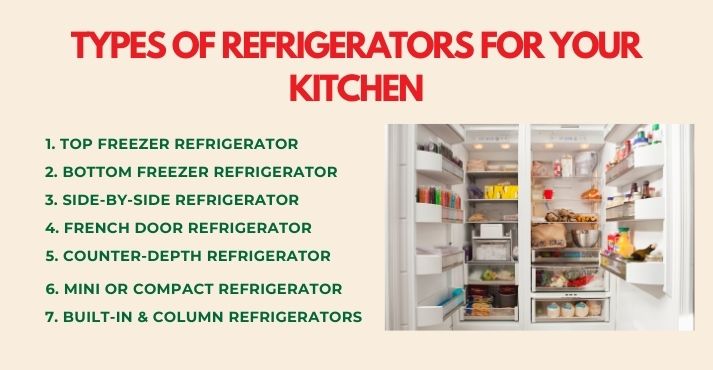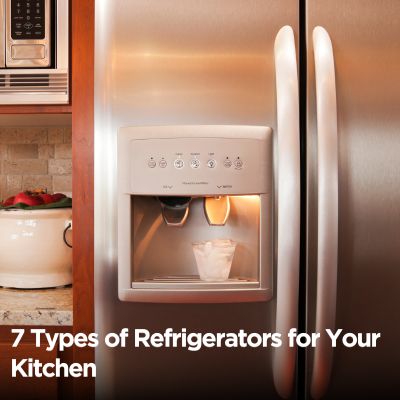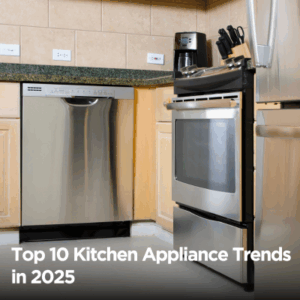Shopping for a new refrigerator can be overwhelming with many options available today. Whether replacing an outdated model or upgrading to a more efficient one, the sheer number of fridge styles and features can make your decision feel like a significant task.
But choosing the right refrigerator is about more than preserving food — it’s also about finding a model that fits your kitchen design, supports your lifestyle, and makes daily tasks more convenient.
In this blog, we’ll discuss 7 major types of refrigerators, highlighting their pros and cons, who they’re best suited for, and how to choose the right one for your kitchen space.
By the end, you’ll be equipped to choose a fridge that keeps your food fresh and perfectly complements your home.
Types of Refrigerators for Your Kitchen

Choosing the right refrigerator involves more than just picking a brand. It’s about understanding which type best suits your space, budget, and lifestyle. With so many different types of fridges available, deciding which one meets your needs can be challenging.
Each refrigerator style offers unique benefits, space considerations, and features. In this section, we’ll break down the 7 most common refrigerator types, helping you make an informed decision.
1. Top Freezer Refrigerator
The top freezer refrigerator has a timeless design with a compartment placed above the fridge. It’s a simple, functional layout that many homeowners prefer for its practicality.
Affordable and widely available, this style remains one of the most accessible options on the market. Its straightforward style makes it easy to use, with a spacious refrigerator section perfect for storing groceries.
Commonly found in smaller kitchens or apartments, it’s an ideal choice for those seeking an efficient, no-frills appliance.
Best For:
- Small households with limited space.
- Apartment dwellers needing compact yet efficient refrigeration.
- Budget-conscious buyers looking for a reliable, basic fridge.
Pros:
- Energy-efficient: Top-freezer models are generally more energy-efficient, often featuring Energy Star ratings for minimal energy consumption.
- More storage in a smaller space: The compact design maximizes refrigerator space, making it an excellent choice for smaller kitchens or tight areas.
- Lower cost: Offering solid functionality at an affordable price, top-freezer fridges are ideal for first-time buyers or those on a budget.
Cons:
- Bending to reach the fridge section: The fridge section sits lower, which may require bending to access commonly used items. This can be inconvenient for those with mobility issues or who frequently use the fridge.
- Less modern features: While functional, top-freezer models lack the advanced features of newer refrigerators, such as smart technology or customizable shelving.
2. Bottom Freezer Refrigerator
The bottom freezer refrigerator has become popular for those who prefer easy access to fresh food without bending down. With the fridge section at eye level, this style offers more comfort when accessing commonly used items like fruits, vegetables, and dairy.
The freezer is located at the bottom, typically with a pull-out drawer, making it convenient for storing bulkier frozen goods.
While the bottom freezer design may cost slightly more than the top freezer option, its increased accessibility and improved organization often justify the price for many buyers.
Best For:
- Home cooks who prioritize eye-level access to fresh ingredients.
- Families or individuals who regularly use fresh foods and want to keep them within easy reach.
- Those who want a modern design but still prefer the space of a traditional fridge and freezer layout.
Pros:
- Easier access to frequently used items: Because the refrigerator section is at eye level, grabbing your favorite snacks, drinks, or leftovers is quicker and more comfortable. This layout especially benefits households that use the fridge more than the freezer.
- Large freezer drawer: The bottom freezer typically includes a spacious, deep drawer. Many models also feature pull-out baskets or dividers to keep frozen foods well-organized, making it easier to find what you need without digging through piles.
- Better ergonomics for fridge use: Since most people use the fridge section more often than the freezer, this layout reduces the need to crouch or bend, making daily use easier on your back and knees.
Cons:
- Freezer requires bending: While having the fridge at eye level is excellent, accessing the freezer does involve bending. This could be a drawback for people with mobility concerns or back problems.
- Often higher cost than top freezer models: Bottom freezer refrigerators usually cost more than top freezer models. The added convenience and modern layout come with a premium, which might not suit every budget.
3. Side-by-Side Refrigerator
The side-by-side refrigerator features a vertical split, with the fridge on one side and the freezer on the other. This layout is perfect for narrow kitchens or spaces where a full-size refrigerator may be too large.
With full-height doors, side-by-side models offer easy access to food and work well in homes and commercial kitchens using smart restaurant technology.
Best For:
- Families who need separate compartments for fresh and frozen items.
- Kitchens with limited door swing space, where traditional fridge doors might not open fully.
- People who like to store frozen items in an organized manner and frequently use ice or water dispensers.
Pros:
- Narrow door clearance: The vertical split and narrow door design make side-by-side refrigerators a great fit for limited space, such as galley-style kitchens. You won’t need as much clearance to open the doors, making them perfect for tight spaces.
- Water/ice dispensers often included: Many models come with built-in water and ice dispensers, offering instant access to filtered water and ice without the need to open the door. This can be a huge convenience for busy households and those who entertain guests regularly.
Good freezer organization: The side-by-side design allows for more organized storage in the fridge and freezer compartments. With adjustable shelves and bins, keeping fresh and frozen foods neatly arranged is easier.
Cons:
- Narrow compartments limit storage of wide items: While the design is great for organization, the narrow shelves in both the fridge and freezer can make it difficult to store large or wide items, such as pizzas, large trays, or big pots. This design might not work well if you frequently store bulkier items.
- Less energy-efficient in some models: Side-by-side refrigerators, especially older models, may not be as energy-efficient as other fridge styles. If you’re concerned about energy efficiency, checking the Energy Star ratings before purchasing is essential.
4. French Door Refrigerator
The French door refrigerator is modern and stylish, offering double doors for the fridge section on top and a pull-out drawer for the freezer below.
This configuration combines elegance with practicality, making it a popular choice for contemporary kitchens. The French door design maximizes accessibility to fresh and frozen food while allowing for more spacious and organized storage.
Best For:
- Modern kitchens looking for a sleek, high-end appliance.
- Entertainers who need ample space for platters and trays.
- Large families who require a generous amount of refrigeration space and easy access to fresh food.
Pros:
- Wide shelves for trays and platters: The double-door design allows for wider shelves, perfect for storing large trays, party platters, and oversized food items that don’t fit in traditional fridges. If you host dinner parties or family gatherings, this fridge style offers the flexibility you need.
- Stylish and spacious: With its elegant design, the French door refrigerator brings sophistication to any kitchen. Its spacious interior provides room for all your groceries, with easy access to fresh and frozen food.
- Smart features often included: Many models come equipped with smart technology, such as Wi-Fi connectivity, temperature control via apps, or even touch-screen displays, adding convenience for tech-savvy users. It’s an excellent option for those looking for kitchen refrigerator styles that offer aesthetics and functionality.
Cons:
- Pricier: French door refrigerators are generally more expensive than other models due to their premium features, spacious design, and stylish appearance. However, the investment may be worth it for those who value form and function.
- Takes up more space: French door refrigerators tend to take up more space in the kitchen due to their larger size. If you’re working with a compact kitchen, this design might not be your best choice.
5. Counter-Depth Refrigerator
A counter-depth refrigerator is a shallower model designed to fit seamlessly with your kitchen cabinets, creating a streamlined, built-in look. It is typically between 24 and 30 inches deep and aligns with standard countertops for a clean, integrated appearance.
These refrigerators offer a polished and uniform aesthetic that complements modern kitchen designs.
While counter-depth fridges are often seen in upscale kitchens, they are also a popular fridge configuration for homeowners and designers looking to balance style with space efficiency in smaller layouts or open-concept spaces.
This type of fridge is convenient in environments where clean lines and space optimization are essential, whether a sleek home setup or a full-service restaurant aiming to maintain a cohesive, clutter-free back-of-house design.
Best For:
- Sleek, built-in kitchen designs where aesthetics are an essential factor.
- Homeowners looking to achieve a seamless and integrated kitchen layout that aligns with cabinet depths.
Pros:
- Streamlined look: Counter-depth refrigerators are ideal for homeowners who want a sleek, minimalist design. The fridge’s shallow profile eliminates the bulging look that standard-depth models can create, providing a clean, modern feel that matches the surrounding cabinetry.
- Space-saving exterior: Due to their shallower depth, counter-depth refrigerators can be an excellent choice for limited space kitchens, giving you more room for walking around or adding other appliances or storage.
Cons:
- Less interior space: Since the unit is shallower than a standard fridge, the interior space is often smaller. You may have less room for large grocery hauls or bulky items. While it’s great for aesthetics, it may not suit larger families or heavy food storage.
- More expensive per cubic foot: Counter-depth models tend to be more expensive per cubic foot than standard-depth refrigerators, making them a more costly option for those seeking a budget-friendly fridge.
6. Mini or Compact Refrigerator
The mini or compact refrigerator is a small, portable fridge for tight spaces like dorm rooms, offices, bedrooms, or small apartments. These fridges store beverages, snacks, or a limited selection of fresh food, perfect for personal use or as a secondary cooling option.
Most compact refrigerators range in height from about 20 to 36 inches and typically offer storage capacity between 1.7 and 4.5 cubic feet, making them an efficient choice for places with limited space.
Compact refrigerators also come in handy in business settings. For example, in cafés or small eateries, they can be used for back-bar beverage storage or even managing restaurant operations in tight prep areas where every inch of space counts.
Best For:
- Dorms, offices, and bedrooms where space is limited and the fridge is primarily used for storing snacks or beverages.
- Small apartments or secondary spaces where a larger fridge isn’t necessary.
- Individuals looking for additional beverage storage in places like wet bars or kitchens with limited space.
Pros:
- Budget-friendly: Mini fridges are one of the most affordable refrigerator options, perfect for those on a tight budget or those who only need basic refrigeration.
- Space-saving: Due to their compact size, mini fridges can fit into any small space, making them ideal for places where full-size refrigerators are too large or unnecessary.
- Easy to move: These fridges are lightweight and portable, allowing you to quickly move them between rooms, apartments, or even take them with you when you move. They’re incredibly convenient for temporary living situations.
Cons:
- Limited capacity: The compact design means limited storage for fresh foods. A mini fridge won’t be sufficient if you need to store a lot of groceries.
- Often lacks freezer section: Most mini fridges have either a small freezer section or none, which can be a drawback if you need to store frozen foods or ice.
7. Built-In & Column Refrigerators
Built-in and column refrigerators are high-end options that combine seamlessly into custom cabinetry, offering a sleek and modern look.
Built-in models align with your kitchen cabinets, while column refrigerators separate the fridge and freezer, offering more flexibility in organizing your space.
These refrigerators are popular in luxury kitchens and among homeowners who want a clean, integrated design. They can even be customized with matching panels to blend into the cabinetry, creating a polished, high-end feel.
In addition to their premium design, these models often come with advanced features like precise temperature control and smart technology, making them a solid choice for anyone who loves cooking or needs extra storage space.
Best For:
- Luxury kitchens where aesthetics and functionality are important.
- Homeowners who want a seamless design and a customizable refrigerator layout.
Pros:
- Seamless appearance: These refrigerators fit seamlessly into your kitchen, offering a custom-built appearance that enhances your space’s overall aesthetic. The integrated style creates a cohesive look with cabinetry, providing a professional and sleek finish.
- Customizable layout: With column refrigerators, you can create a custom layout by separating the fridge and freezer. You can place them where they best fit within your kitchen’s workflow, which is ideal for those with specific storage needs.
- Higher resale value: Due to their luxury appeal and custom design, built-in refrigerators can increase your home’s resale value, making them a smart investment for design-conscious homeowners.
Cons:
- Very expensive: Built-in and column refrigerators are typically highly priced, especially compared to other styles. They are a significant investment and may not be the best option for those on a budget.
- Requires professional installation: Installing these refrigerators requires professional help due to their custom nature. This means additional costs for installation and potential delays.
These 7 refrigerators represent the different fridge styles and designs catering to various needs and preferences.
From compact options perfect for dorm rooms to luxury, built-in units that match your kitchen, there’s a refrigerator for every lifestyle and kitchen layout.
When choosing the best refrigerator for your needs, it’s important to consider the layout and how the appliance fits into your kitchen design and daily routine.
How to Choose the Right Refrigerator for Your Kitchen

Choosing the right refrigerator can be difficult, as there are so many options to consider. This guide will help you narrow your choices by focusing on essential factors to ensure your new fridge fits perfectly in your kitchen and meets your needs.
Before purchasing, consider your kitchen layout, storage needs, energy usage, and other features that may make life easier. You might also want to check out a Food Service & Hospitality Equipment Trade Show to explore the latest in refrigeration and kitchen equipment.
1. Consider Your Kitchen Layout
Start by measuring your available space. Check the height, width, and the space needed for the door to swing open. Also, think about counter clearance and cabinet depth.
Knowing your kitchen’s layout will help you choose the right fridge style, whether a compact or larger, built-in unit.
2. Evaluate Storage Needs
Consider how many people you’re feeding and your typical meal prep habits. Do you need more space for frozen food, or is your focus on fresh food? A larger family may benefit from a French door or side-by-side model, while a compact fridge may suit smaller homes or apartments.
If you’re in the food service business, like a full-service restaurant, understanding your storage needs is crucial to running smooth operations.
3. Energy Efficiency
Look for refrigerators with ENERGY STAR ratings, indicating they use less energy and can save you money on utility bills. Also, consider models with inverter compressors, which are more energy-efficient than standard compressors.
Energy-efficient appliances are becoming increasingly popular in commercial kitchens, especially as technology in the restaurant industry continues to advance.
4. Bonus Features
Refrigerators today come with a variety of helpful features. Consider models with smart connectivity, ice and water dispensers, humidity controls, and Wi-Fi functionality.
These features can make your kitchen convenient, especially for those who want to stay connected or have specific needs.
For businesses, these advanced features can make managing daily tasks more efficient, whether at home or in a commercial kitchen.
Expert Tips for Buying a Refrigerator

When shopping for a new fridge, making an informed decision is important to ensure you get the best value for your money. Here are some expert tips to guide your purchase and help you avoid common mistakes:
1. Check Warranty and Brand Support
Long-term reliability matters when investing in a refrigerator. Look for brands that offer solid warranties and strong customer support. A good warranty can save you from costly repairs and ensure you have help if anything goes wrong.
2. Don’t Overbuy Features
While modern refrigerators have many advanced features, it’s easy to get caught up in the extras. Stay within your budget by focusing on the essentials.
Features like ice makers, water dispensers, and smart technology can be useful, but they’re not always necessary, especially if you’re simply looking for basic refrigeration.
3. Match with Your Lifestyle
Think about your daily routine and how you use your fridge. If you entertain often, prioritize space and design to accommodate large platters or beverages.
If you cook less or live in a small space, a compact and energy-efficient model may be all you need, saving space and energy.
Conclusion
Selecting the right refrigerator is more than just a practical decision; it’s about finding a model that complements your kitchen’s layout, fits your lifestyle, and meets your storage needs.
Whether you’re looking for a compact fridge for a smaller space or a high-end built-in model that offers both style and functionality, understanding the different types can make the selection process easier.
By evaluating available space, energy efficiency, and additional features, you can confidently choose a refrigerator that enhances your kitchen’s design and your day-to-day living.
Ultimately, making an informed decision means taking the time to assess your specific needs and preferences. You’ll enjoy a more organized, efficient kitchen with the right refrigerator for years.
Don’t forget to consider long-term factors such as energy usage, warranty support, and future needs as you make your purchase.
Whether it’s for a family home, a professional kitchen, or a smaller space, the right fridge is out there, and it’s just a matter of knowing what works best for you.












